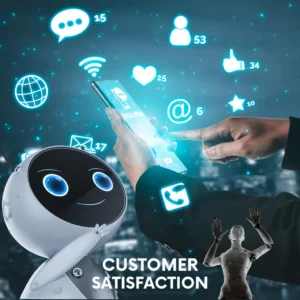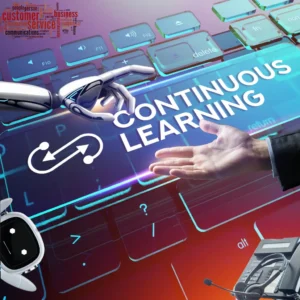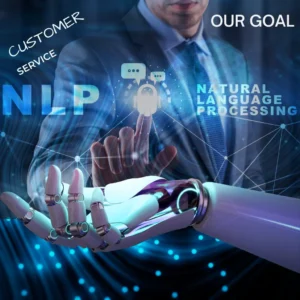
Revolutionizing Service Excellence
Unleashing the Power of Customer Service Predictive Analytics and Recommendations!
In the dynamic customer service landscape, integrating advanced technologies is imperative for staying at the forefront of industry innovation.
As a stalwart in the Customer Service domain for 15 years, our company is embarking on a transformative journey, centring our focus on Customer Service Predictive Analytics and Recommendation Systems.
Recognizing the pivotal role of automation, we aim to harness the power of these cutting-edge tools to streamline operations, proactively address customer needs, and elevate the overall service experience.
This discussion delves into the requisite business and software knowledge, hardware infrastructure, training protocols, and integration strategies for successfully implementing these sophisticated systems.
Table of Contents

Arindam Roy
An Automation Consultant with 25+ years of IT Experience
5 Predictive Analytics and Recommendation Tool ideas for the Customer Service
In Customer Service Predictive Analytics and Recommendation Systems, our company, with 15 years of expertise, is poised to revolutionize customer interactions through cutting-edge AI technologies. We are committed to automating processes and maintaining our market leadership by introducing the following innovative tools:
1. Customer Behaviour Prediction Tool:
Our Customer Behaviour Prediction Tool analyzes historical data and customer interactions by harnessing machine learning algorithms. This tool provides valuable insights into customer behaviour patterns, enabling businesses to anticipate future actions and tailor their services accordingly. Understanding customer preferences can help companies optimize their service strategies and enhance customer experience.
2. Product Recommendation Engine:
The Product Recommendation Engine employs sophisticated algorithms to provide product recommendations based on customer preferences. By analyzing historical purchase data and customer behaviour, this tool ensures personalized recommendations, contributing to increased sales and customer satisfaction. The engine continuously refines its suggestions, adapting to evolving customer preferences and market trends.
3. Forecasting Tool for Service Demand:
Our Forecasting Tool anticipates customer service requirements by utilizing predictive analytics. By analyzing historical service data, this tool accurately predicts fluctuations in demand, allowing businesses to allocate resources efficiently. This proactive approach ensures optimal service delivery, minimizing response times and enhancing customer satisfaction. The tool adapts to changing patterns, providing a dynamic solution for service demand forecasting.
4. Predictive Analytics for Identifying Potential Issues:
Leveraging machine learning capabilities, our Predictive Analytics for Identifying Potential Issues scans vast datasets to identify and address potential problems before they impact customers. By detecting patterns indicative of upcoming issues, businesses can take preemptive measures to resolve issues, reducing downtime and enhancing overall service reliability. This tool is a proactive solution to maintain high customer satisfaction.
5. Churn Prediction Tool for Proactive Customer Retention:
Our Churn Prediction Tool employs advanced machine learning models to predict customers at risk of churning. This tool identifies potential churn risks by analyzing various factors such as usage patterns, feedback, and historical data. With this information, businesses can proactively implement targeted retention strategies to engage and retain customers. This tool is essential for customer-centric organizations aiming to minimize churn and maximize customer loyalty.
In summary, our Customer Service Predictive Analytics and Recommendation Systems offer a comprehensive suite of tools to empower businesses to understand customer behaviour, optimize services, forecast demand, address potential issues, and proactively retain customers. With these tools, we are poised to lead the market by providing unparalleled insights and efficiency in customer service operations.
Customer behaviour prediction tool
Business Knowledge Required:
- Customer Behavior Analysis: Deep understanding of customer behaviour within the specific industry, including critical factors influencing purchasing decisions, preferences, and patterns.
- Data Governance: Knowledge of data governance principles to ensure ethical and compliant use of customer data for predictive analytics.
- Industry Trends: Awareness of current trends in customer service, technology, and market dynamics to align predictive models with evolving customer expectations.
Software Knowledge Needed:
- Machine Learning Algorithms: Proficiency in developing and implementing machine learning algorithms tailored for customer behaviour prediction, considering factors such as clustering, regression, and classification.
- Data Processing and Analysis: Skills in data processing tools and analytics platforms to efficiently clean, preprocess, and analyze large datasets.
- Recommendation Algorithms: Expertise in collaborative filtering and other recommendation algorithms to build a compelling product recommendation engine.
Hardware Needed to Run the Tools:
- Scalable Computing Power: Adequate computing power, potentially utilizing cloud services, to handle the computational demands of training and deploying machine learning models.
- Data Storage Infrastructure: Robust data storage infrastructure for predictive analytics to accommodate and manage large volumes of historical data.
Training Required to Run the Tools:
- Model Training: Training data scientists or machine learning specialists to fine-tune predictive models for accurate customer behaviour prediction.
- User Training for Utilization: Training for relevant personnel on interpreting and utilizing the insights generated by the predictive analytics and recommendation systems.
Integrations Necessary:
- CRM Systems: Enrich customer profiles and personalize interactions via CRM integration and predictive insights.
- E-commerce Platforms: Integration with e-commerce platforms to seamlessly implement product recommendations and enhance the customer shopping experience.
Comparative Tools Already Available in the Market:
- IBM Watson Customer Experience Analytics: Offers predictive analytics capabilities to understand customer behaviour and preferences, enabling personalized interactions.
- Adobe Target: Provides a recommendation engine for e-commerce businesses, utilizing machine learning to optimize content and product suggestions.
Recommendation:
Considering predictive analytics’ complexity and the availability of established tools in the market, it is recommended that an existing solution be bought and customized. This approach allows leveraging the expertise of established providers while tailoring the tool to specific business needs within the Customer Service Predictive Analytics and Recommendation Systems.
Cost/Benefits Analysis on the Recommendation:
- Costs:
- Licensing Fees: Incurred costs for purchasing a subscription or licensing the chosen predictive analytics and recommendation platform.
- Customization Costs: Initial development costs for customizing the tool to align with specific customer service requirements.
- Benefits:
- Quick Implementation: Faster implementation compared to building from scratch, leading to the speedier realization of benefits.
- Expertise Access: Access to the expertise of established providers, ensuring the efficiency and accuracy of predictive models.
- Continuous Updates: Regular updates from the platform provider, keeping the tool current with advancements in predictive analytics and recommendation technologies.
In conclusion, the recommendation to buy and customize an existing predictive analytics and recommendation platform offers a balanced approach, combining efficiency, accuracy, and customization within the context of Customer Service Predictive Analytics and Recommendation Systems.
Product recommendation engine
Business Knowledge Required:
- Customer Behavior Understanding: A comprehensive understanding of customer behaviour within the specific industry, including factors influencing purchasing decisions, preferences, and historical purchasing patterns.
- Product Knowledge: In-depth knowledge of the company’s products or services to align recommendations with the product catalogue and customer expectations.
- Market Trends: Awareness of market trends, competitor offerings, and industry dynamics to ensure recommendations align with current market demands.
Software Knowledge Needed:
- Collaborative Filtering Algorithms: Proficiency in implementing collaborative filtering algorithms, the cornerstone of a product recommendation engine, to analyze user behaviour and preferences.
- Machine Learning: Expertise in machine learning techniques to train models on historical data and continuously refine recommendations based on real-time customer interactions.
- Data Processing: Skills in data processing for cleaning, preprocessing, and transforming raw data into a suitable format for training and deploying recommendation models.
Hardware Needed to Run the Tools:
- Scalable Computing Resources: Adequate computing power, potentially leveraging cloud services, to handle the computational demands of training and serving machine learning models for real-time recommendations.
- Data Storage Infrastructure: Robust data storage infrastructure to store and manage extensive customer interactions and product information datasets.
Training Required to Run the Tools:
- Model Training: Training data scientists or machine learning specialists to develop and fine-tune recommendation models for optimal performance.
- System Integration Training: This is training for IT personnel or developers on integrating the recommendation engine into existing customer service systems.
Integrations Necessary:
- E-commerce Platforms: Seamless integration with e-commerce platforms to deliver personalized product recommendations directly to customers during their online interactions.
- Customer Relationship Management (CRM) Systems: Integration of customer profiles, purchase history, and preferences with the recommendation engine for a personalized experience can be achieved by integrating with CRM systems.
Comparative Tools Already Available in the Market:
- Amazon Personalize: Amazon’s recommendation service provides personalized product recommendations based on user behaviour and preferences.
- Google Cloud AI Recommendations: Google’s recommendation service is a cloud-based solution that employs machine learning to deliver personalized recommendations to its users.
Recommendation:
Given the complexity and availability of specialized tools in the market, it is recommended that you buy and customize an existing product recommendation engine. This approach allows the company to benefit from established expertise while tailoring the tool to specific business needs within Customer Service Predictive Analytics and Recommendation Systems.
Cost/Benefits Analysis on the Recommendation:
- Costs:
- Licensing Fees: Incurred costs for purchasing a subscription or licensing the chosen recommendation engine platform.
- Customization Costs: Initial development costs for customizing the tool to align with specific product catalogues and customer behaviour requirements.
- Benefits:
- Speed to Market: Implementation is faster than building from scratch, leading to quicker benefits realization and improved customer engagement.
- Expertise Access: Access to the specialized expertise of established providers, ensuring the efficiency and accuracy of recommendation models.
- Continuous Updates: The platform provider regularly updates the tool, keeping it current with advancements in recommendation algorithm technology.
When considering Customer Service Predictive Analytics and Recommendation Systems, it is recommended that you buy and customize an existing product recommendation engine. This approach balances efficiency, accuracy, and customization.
Forecasting tool for service demand
Business Knowledge Required:
- Service Demand Patterns: In-depth understanding of historical service demand patterns, including seasonality, peak hours, and factors influencing fluctuations in customer inquiries or issues.
- Resource Allocation Strategies: Knowledge of current resource allocation strategies within the customer service domain, considering factors like workforce availability, skill sets, and operational costs.
- Industry Dynamics: Awareness of industry-specific dynamics and trends affecting customer service demand to ensure accurate forecasting.
Software Knowledge Needed:
- Predictive Analytics Algorithms: Proficiency in implementing predictive analytics algorithms capable of analyzing historical service data to identify trends and patterns for forecasting.
- Data Processing and Analysis: Skills in data processing and analysis tools to clean, preprocess, and derive actionable insights from large datasets of customer service interactions.
- Resource Allocation Models: Expertise in developing models that optimize resource allocation based on the forecasted service demand and available resources.
Hardware Needed to Run the Tools:
- Scalable Computing Resources: Adequate computing power, potentially leveraging cloud services, to handle the computational demands of training predictive models and real-time resource allocation.
- Data Storage Infrastructure: Robust data storage infrastructure to manage historical customer service data and facilitate efficient analysis.
Training Required to Run the Tools:
- Model Training: Training data scientists or machine learning specialists to fine-tune predictive models for accurate service demand forecasting.
- Resource Management Training: Training for operational staff to understand and implement resource allocation strategies based on the forecasted demand.
Integrations Necessary:
- Customer Relationship Management (CRM) Systems: CRM tools are integrated to access customer profiles, service history, and other relevant data for more accurate predictions.
- Workforce Management Systems: Integration with workforce management systems to align forecasted service demand with staff schedules and skill sets for optimal resource allocation.
Comparative Tools Already Available in the Market:
- Genesys Predictive Engagement: Offers predictive engagement tools for customer service, including forecasting and resource allocation capabilities.
- Salesforce Service Cloud: Incorporates AI-driven analytics and forecasting tools to optimize service delivery and resource allocation.
Recommendation:
Considering the complexity and availability of specialized tools in the market, it is recommended that a company buy and customize an existing forecasting tool for service demand. This approach allows the company to customize the tool to their business needs while leveraging established Customer Service Predictive Analytics and Recommendation Systems expertise.
Cost/Benefits Analysis on the Recommendation:
- Costs:
- Licensing Fees: Incurred costs for purchasing a subscription or licensing the chosen forecasting tool platform.
- Customization Costs: Initial development costs for customizing the tool to align with specific service demand patterns and resource allocation strategies.
- Benefits:
- Efficiency Gains: Faster implementation compared to building from scratch, leading to quicker efficiency gains in service demand forecasting and resource optimization.
- Expertise Access: Access to the specialized expertise of established providers, ensuring the accuracy and reliability of forecasting models.
- Continuous Updates: The platform provider provides regular updates, keeping the tool current with advancements in predictive analytics and resource allocation technologies.
In conclusion, the recommendation to buy and customize an existing forecasting tool for service demand offers a balanced approach, combining efficiency, accuracy, and customization within the context of Customer Service Predictive Analytics and Recommendation Systems.
Predictive analytics for identifying potential issues
Business Knowledge Required:
- Customer Service Operations: In-depth understanding of the company’s customer service operations, including workflows, processes, and common challenges faced by customer support teams.
- Historical Issue Data: Knowledge of historical customer service data, including common types of issues, their resolutions, and patterns indicating potential problems.
- Customer Feedback Analysis: Familiarity with customer feedback mechanisms and sentiment analysis to interpret and integrate qualitative insights into the predictive analytics model.
Software Knowledge Needed:
- Machine Learning Algorithms: Proficiency in developing and implementing machine learning algorithms capable of analyzing historical data to predict potential issues before they escalate.
- Data Processing and Analysis: Skills in data processing and analysis tools to clean, preprocess, and derive actionable insights from large datasets of customer service interactions.
- Anomaly Detection Techniques: Expertise in anomaly detection techniques within machine learning to identify irregular patterns indicative of potential problems.
Hardware Needed to Run the Tools:
- Scalable Computing Resources: Adequate computing power, potentially leveraging cloud services, to handle the computational demands of training and deploying machine learning models for real-time issue prediction.
- Data Storage Infrastructure: Robust data storage infrastructure to effectively manage and analyze historical customer service data.
Training Required to Run the Tools:
- Model Training: Training data scientists or machine learning specialists to fine-tune predictive models for accurate identification of potential issues.
- User Training for Interpretation: Training for customer support teams or relevant personnel on interpreting and acting upon the insights provided by the predictive analytics tool.
Integrations Necessary:
- Customer Relationship Management (CRM) Systems: Integrate with CRM systems to access customer profiles, service history, and other relevant data for more accurate predictions.
- Ticketing Systems: Integration with customer service ticketing systems to streamline issue tracking and resolution processes.
Comparative Tools Already Available in the Market:
- Zendesk Explore: Offers analytics and reporting tools that can be customized to identify potential issues and trends in customer service interactions.
- Freshdesk AI-powered Predictions: Utilizes AI to predict potential issues, automate ticket assignments, and provide insights for proactive customer service.
Recommendation:
Given the specialized nature of predictive analytics for identifying potential issues and the availability of existing tools in the market, it is recommended that a company buy and customize an existing solution. This approach allows the company to benefit from established expertise while tailoring the tool to specific business needs within Customer Service Predictive Analytics and Recommendation Systems.
Cost/Benefits Analysis on the Recommendation:
- Costs:
- Licensing Fees: Incurred costs for purchasing a subscription or licensing the chosen predictive analytics platform.
- Customization Costs: Initial development costs for customizing the tool to align with specific customer service operations and issue identification requirements.
- Benefits:
- Efficiency Gains: Implementing a solution quickly compared to building from scratch leads to quicker efficiency gains in identifying and addressing potential issues.
- Expertise Access: Access to the specialized expertise of established providers, ensuring the accuracy and reliability of predictive models.
- Continuous Updates: Regular updates from the platform provider keep the tool current with advancements in predictive analytics and issue identification technologies.
In conclusion, the recommendation to buy and customize an existing predictive analytics platform strikes a balance between efficiency, accuracy, and customization within Customer Service Predictive Analytics and Recommendation Systems.
Churn prediction tool for proactive customer retention
Business Knowledge Required:
- Customer Lifecycle Understanding: In-depth knowledge of the customer lifecycle, including acquisition, engagement, and potential reasons for churn, to inform the development of accurate predictive models.
- Customer Segmentation Strategies: Understanding customer segments’ behaviours to tailor the churn prediction model for diverse customer profiles.
- Retention Strategies: Familiarity with effective customer retention strategies and programs to integrate proactive measures into the churn prediction tool.
Software Knowledge Needed:
- Machine Learning Algorithms: Proficiency in implementing machine learning algorithms for predictive modeling, such as classification models, to identify customers at risk of churning.
- Data Processing and Analysis: Skills in data processing and analysis tools to clean, preprocess, and derive actionable insights from extensive customer interactions and historical data datasets.
- Feature Engineering: Expertise in feature engineering to select and create relevant features that contribute to accurate churn predictions.
Hardware Needed to Run the Tools:
- Scalable Computing Resources: Adequate computing power, potentially leveraging cloud services, to handle the computational demands of training and deploying machine learning models for real-time churn prediction.
- Data Storage Infrastructure: Robust data storage infrastructure to effectively manage and analyze historical customer data.
Training Required to Run the Tools:
- Model Training: Training data scientists or machine learning specialists to fine-tune predictive models to identify customers at risk of churning accurately.
- User Training for Retention Strategies: Training for customer support and marketing teams on interpreting predictions and implementing proactive retention strategies.
Integrations Necessary:
- Customer Relationship Management (CRM) Systems: Integrate with CRM systems to access customer profiles, service history, and other relevant data for more accurate churn predictions.
- Marketing Automation Platforms: Integration with marketing automation tools to seamlessly execute targeted retention campaigns based on predictions.
Comparative Tools Already Available in the Market:
- IBM Watson Customer Experience Analytics: Offers churn prediction capabilities, providing insights into customer behaviours and preferences.
- Salesforce Einstein Analytics: Leverages AI for predictive analytics, including churn prediction, and integrates with CRM to seamlessly execute retention strategies.
Recommendation:
Given the specialized nature of churn prediction and the availability of existing tools in the market, it is recommended that a churn prediction tool be bought and customized. This approach allows the company to benefit from established expertise while tailoring the tool to specific business needs within Customer Service Predictive Analytics and Recommendation Systems.
Cost/Benefits Analysis on the Recommendation:
- Costs:
- Licensing Fees: Incurred costs for purchasing a subscription or licensing the chosen churn prediction platform.
- Customization Costs: Initial development costs for customizing the tool to align with specific customer service operations and retention strategies.
- Benefits:
- Efficiency Gains: Faster implementation compared to building from scratch, leading to quicker efficiency gains in identifying and addressing potential churn risks.
- Expertise Access: Access to the specialized expertise of established providers, ensuring the accuracy and reliability of churn prediction models.
- Continuous Updates: Regular updates from the platform provider keep the tool current with advancements in predictive analytics and churn prediction technologies.
Regarding Customer Service Predictive Analytics and Recommendation Systems, buying and customizing an existing churn prediction tool can be an efficient, accurate, and customizable option. This approach balances different factors and can be an excellent choice.
Conclusion
In conclusion, as we embark on the journey to enhance our customer service operations, the pivotal role of Customer Service Predictive Analytics and Recommendation Systems becomes abundantly clear. Leveraging 15 years of domain expertise, our commitment to automation and the integration of cutting-edge AI technologies positions us as market leaders. Creating specialized tools, such as predictive analytics for identifying potential issues and a churn prediction tool for proactive customer retention, underscores our dedication to staying ahead in the ever-evolving customer service landscape.
The multifaceted business knowledge required, spanning customer lifecycles, segmentation, and retention strategies, forms the bedrock of our approach. Complemented by software proficiency in machine learning algorithms, data processing, and feature engineering, our tools are poised to provide nuanced insights into customer behaviours and predict future patterns. The necessity for scalable computing resources and robust data storage infrastructure, potentially utilizing cloud services, emphasizes the commitment to efficiency and real-time analytics.
With integrations seamlessly woven into CRM systems and marketing automation platforms, these tools bridge the gap between predictive insights and actionable strategies, empowering our teams for proactive and personalized customer interactions. The market comparison highlights the availability of specialized tools, yet the recommendation leans towards buying and customizing existing solutions to capitalize on expertise while tailoring tools to our specific needs.
The cost-benefit analysis underscores the efficiency gains, expertise access, and continuous updates with the recommended approach. As we propel our customer service operations into the future, these Customer Service Predictive Analytics and Recommendation Systems stand as the linchpin in our pursuit of unparalleled service excellence and customer satisfaction.
Related Articles
- 50 AI Tools for the Customer Services Domain
- 5 Facial Recognition and Emotion Analysis Tools of Customer Service
- 5 Customer Service Speech Recognition and Processing Tools
- 5 Customer Service Tolls for Automation and RPA
- 5 Customer Service Natural Language Processing (NLP) Tools
- 5 Customer Service Tools for Knowledge Management
- 5 Customer Service Tools for Continuous Learning and Improvement
- 5 Customer Service Tools for Customer Survey Analysis
- 5 Customer Service Tools for Social Media Monitoring
- 5 Customer Service Tools for Data Security and Privacy





















